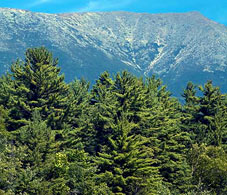Hiking in Maine
Hiking the mountains of Maine (even in summer) is very rewarding and fun. But it’s also not something to take lightly. Even though the mountains may not be 10,000 feet high, many have “significant" vertical gain, and regional geology can make the trails more difficult in sections than you’d expect. The tree-line is also lower (3700-4000 feet) since we are farther north than most U.S. mountain ranges. Finally, the weather can change rapidly as you ascend. In fact, snow has occurred in every month of the year above tree-line – so take heed!

Mount Katahdin in Maine
Mountain Hiking Maine; The Basics
-
Sign-in/Sign-out at any trail-head registers.
-
Stay on the trails! Staying on marked trails is safer, and helps preserve the flora which is especially fragile in the alpine zone (the region above tree line – approximately 3700-4000 feet in Maine).
-
Turn back at the “hint" of any bad weather, or, if darkness is approaching (and subtract at least 1.5 hours from the normal sunset in the mountains).
-
Allow equal time for descents as for ascents. Trails in Maine usually have difficult footing in many locations. So, have a “turnaround time" chosen before you climb.
-
Choose routes wisely and with respect to the abilities of the least-experienced group member.
-
Carry a copy of the “AMC Maine Mountain Guide" (which contains great trail information and detailed maps).
-
If you plan to hike the high peaks within Baxter State Park, visit their website athttp://www.baxterstateparkauthority.com/ for the latest on trail conditions and Park regulations.
Lightning Safety While Walking, Hiking and Climbing
All safe lightning practices involve the fact that you will not always have a clear view of approaching weather as you ascend a mountain, or, as you walk in heavily wooded terrain. However, there are still warning signs that can help you stay safe. When you become aware of them, you should get below tree-line, out of an open field, or off a ridge or summit – immediately. If you hear thunder, then you are able to be struck by lightning! If you can SEE lightning the distance, then you are MUCH MORE likely of being struck.
How to Respond if You Hear Thunder or See Lightning in the Distance:
-
Retreat from ALL alpine areas (ridges, open areas and summits above tree line).
-
Do not become the highest object in an open area.
-
Do not remain near any objects that rise abruptly from your immediate area; like lone trees.
-
Do not seek shelter in shallow over-hanging caves.
-
Avoid low areas that can collect water, or flowing water areas.
-
TURN CELL PHONES OFF.
-
Avoid proximity to metal objects; including those in or on your pack – and cooking pots, tent poles, stoves or pack frames.
IF you are caught in a thunderstorm, do the following:
-
Find the lowest point of open area and move there quickly.
-
Make sure the place you pick is not subject to water build-up or flooding.
-
On open ground, squat low on something as dry as possible (like a non-metallic pack or sleeping bag), keep your feet close together, make yourself the smallest possible object with the least contact on the ground. DO NOT lie down.
Groups: Be sure that everyone understands the need to be aware of changing weather conditions. Trip leaders should appoint someone as the “lightning and thunder lookout". Plan for extra time to get everyone below tree-line before a storm is upon you! BUT, if caught above tree-line as a group, “spread out" – to avoid multiple strike potential due to " side flashes".
Photography
Wildlife should be enjoyed – but from a safe distance (especially Moose and Black Bear). Remember you are visiting their home!
-
Do not leave the trail to chase after animals for photos. If you really want to photograph larger animals, you might take a Moose and wildlife watching Safari, or, at least ask rangers or local guides about the best times and locations to see animals “safely". Using both respect and knowledge will enable you to take some great pictures – without disturbing species, risking injury, or affecting egg incubation, and other birthing related periods.
-
Also, do NOT feed ANY wild animal for a photograph – or for any other reason!
Pack Essentials for Hikers in Maine
Water: Always carry water (at least 2 quarts/person when climbing any of the mountains). Consider trailside springs as unreliable; even those named as “springs" on maps – especially in the Katahdin “High Peaks" region.
Flashlights: Plan hikes with the intention of finishing in daylight, but ALWAYS carry a flashlight as a precaution. Head lamps are best since they are “worn" and tend to point in the direction you are looking (Baxter State Park Regulation #170).
Food and clothing: Bring extra.. Like candies, nuts or dried fruit; in addition to your meals and liquids. Also, wear pile or wool shirts and/or sweaters, hats (brimmed are good on very sunny days), extra socks, and rain gear.
Foot-wear: Mountain trails in this region are irregular, rocky, and slippery even in summer. Footing can therefore be difficult. For safety, be sure that your foot-wear is designed for such conditions. Tennis shoes are not suitable for mountain climbing.
First aid: Supplies such as band aids, ace bandages, and mole skin should be carried (at a minimum) to take care of you and those hiking in your group. The most common first aid problem hiking are blisters!
Maps – Guide book: The “AMC Maine Mountain Guide" is a good start. Know your route(s), where you are, and have alternatives for poor trail conditions, bad weather, and weak climbers and hikers.
Other Suggestions: Carry a compass, matches, foil emergency blanket, whistle, parachute cord, knife, pack repair kit – at a minimum.
